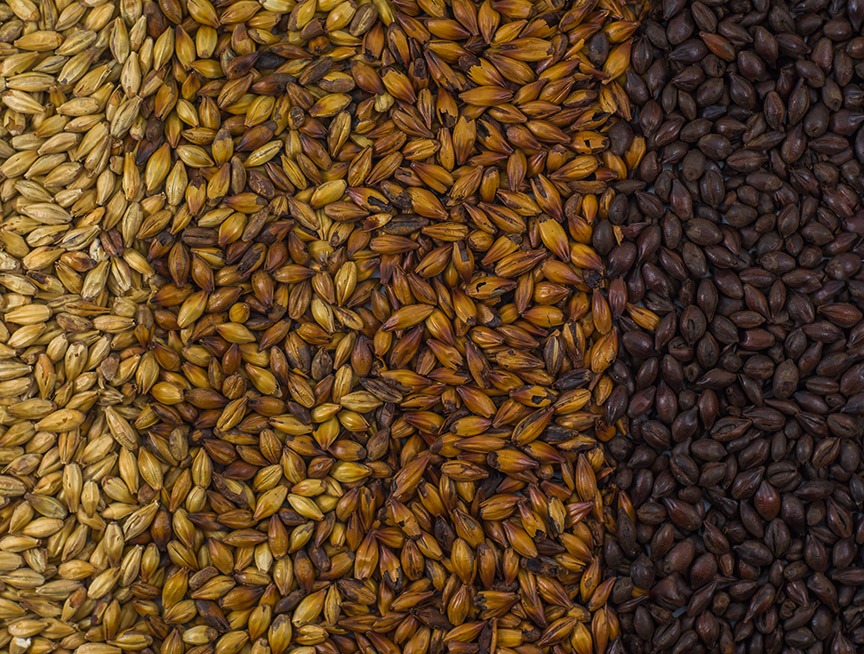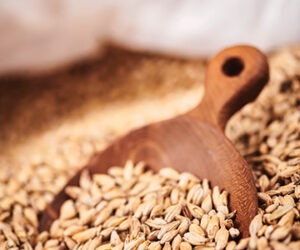The Dark Side of Malt

Hops may be having their day, and the library of yeast we have access to as homebrewers continues to grow. So, where does that leave malt?
It’s the backbone, the soul, and the purveyor of flavor it’s always been! The trick to much of malt’s flavor is in the malting process itself, as there are numerous ways maltsters manipulate its flavor. One way is in a roaster, delivering us delicious dark malts. Those lightly darkened brown and light chocolate malts up to raven-colored roasted barleys and black malts. The variety of dark roasted malt out there is an adventure for every brewer to explore.
As a brewer looking to brew with dark malts there are decisions to make. Quantity, specific malt type, and process decisions all factor into the resulting flavor that goes in your beer. You can subtly add some color or dryness to your beer’s finish through a small percentage — just a handful sometimes — or you can dive right in to big, rich, dark roasted flavors. It can all be provided in the small package of dark roasted malt. Let’s try to better understand these malts and how to use them by looking at how they are made, what malts are available, and how best to use them both subtly and aggressively.
Making Dark Malt
Most dark roasted malts go through the typical malting process prior to ending up in a roaster. The malting process involves:
Steeping: The grain hydrates in large tanks, water completely covering the grain bed. These are aerated so the grain doesn’t die (it’s still a living seed at this point). Water might be changed over 1–2 days. This hydrates the grain to over 40% water.
Germination: The grain is now laid in beds that allow the grain to grow between 4–6 days. The grain must be turned so rootlets don’t grow into each other, leaving the maltster with one big clump of grain. “Green malt,” as it’s now known, may make its way to a roaster wet from this stage. This is most popular with caramel malts.
Kilning: Gentle drying for 12–36 hours is the final stage in the malting process. This solidifies the seed as malt as it halts germination.
Malt meant for a life other than as a type of base malt is sent to the roaster. This is typically a large cylinder shaped “drum roaster” designed to keep the malt moving. This aids in even heating so there isn’t a big lump of scorched malt at the bottom. Many are directly gas-fired, as a significant amount of heat is needed. It’s not uncommon for roaster temperatures to be in the 500–600 °F (260–315 °C) range. Over a carefully monitored 2–4 hour period of roasting, malt colors and flavors develop.
Most roasting drums are equipped with a way to “quench” or lightly wet the malt, which keeps it from smoking too much or starting on fire. Some dark malt is essentially burnt to a crisp, in a controlled fashion, effectively becoming completely charred and carbonized.
Types of Dark Malt
There’s a large variety of roasted dark malts on the market. They all share some common traits:
• They can be used in small amounts for color adjustment, though some may lend a small amount flavor.
• Most will aid in head retention.
• Flavor varies, but most fall close together on a flavor wheel with notes of dark chocolate, coffee, and dark roasted malt/grain flavor present in some varying amount.
• Many will help dry your beer, cutting sweetness and creating a clean malt finish.
• Many will also enhance other malt flavors present in your beer when well balanced.

Depending on the maltster there are several names given to dark malts. Some might be unique, trademarked, or used in specific countries. Let’s look at some of the most popular types available:
Pale Chocolate Malts (190–260 °L)
Pale chocolate malts have their own very specific flavor palate. They can range from milk chocolate to a nutty coffee flavor depending on the usage and the color the maltster decides to roast it to. Pale chocolate malt is a fun tool in your dark malt arsenal that is very at home in porter and brown styles, but it can also be fun to experiment with in other styles.
Roasted Barleys (300–600 °L)
The most common non-malted dark grain that gets roasted. Very straightforward coffee notes come through in most roasted barleys. They add the classic Irish stout flavor but find their way into more complex dark beers as well. Known for creating a dry finish, roasted barley also enhances aroma, head retention, and mouthfeel.
Chocolate Malts (330–460 °L)
Chocolate malts can be somewhat of a surprise when first used, as most have quite intense flavors when used in larger quantities. Think super rich dark cocoa, as well as coffee notes. Chocolate malts can be quite complex compared to darker roasted malts, as not all of the malt character is lost in the roasting process. Chocolate malts can vary in color and flavor by malthouse, based on roasting technique and malt used.
Dehulled, Dehusked, and Hull-less Roasted Malts and Roasted Barleys (400–550 °L)
Maltsters may remove the hull, a source of astringency, from barley to create a much less bitter finished product. Maltsters may also choose to use a hull-less grain, such as wheat or rye, for similar reasons. Dehulled, dehusked, and hull-less dark malts have seen a surge in usage through their versatility to color beer without adding astringency, but also in styles like Cascadian dark ale (black IPA), American stouts, and other black beers where acidic notes and bitterness are not welcome.
Black Malts (470–630 °L)
Sometimes referred to as “Black Patent,” black malts are used to add an inky black color and complex notes of licorice, dark chocolate, coffee, acid, and char to stouts and porters. They can also be sparingly used to boost color without contributing much flavor in a range of styles. But when used in excess or without properly balancing brew water chemistry, black malts can result in horribly bitter and
acidic flavors.
Other Dark Malts (60–650 °L)
You’ll find a variety of other dark malts from the aptly named brown malt, which marks our entry into dark roasted malts at around 200 Lovibond. Don’t let the light color fool you: It’s rich in roast and coffee flavor (in fact, it’s been called “coffee malt”). Roasted wheats can be almost bitterless in higher quantities. Besides pale chocolate malt, you might also find dark chocolate, falling between chocolate and black malt. Maltsters have made sure to give you plenty of tools to add roasty goodness to your next beer — the hardest part is finding time to use them all.
The Malt Misnomer
There are also plenty of grains that end up in roasters that have not been malted. These are often referred to by their grain name followed by “Roasted Barley.” Although black malt or chocolate malt are barley, they’ve been through the malting process. You’ll also find roasted wheat, roasted oats, and other varieties of roasted products that may be less clear whether they’ve been malted or not. Either way, dark roasted malts and dark roasted grains shouldn’t be relied on for too much starch (sugar contribution) as it’s likely been fried away in the roasting process.
Styles & Usage
The most common styles for dark malts, as you might suspect, are stouts and porters. This ranges from brown porters to obsidian black Russian imperial stouts. Other common styles that highlight dark malts are brown ales, dunkels, and some specialty Belgian beers. Copper and orange beer styles like Mexican lager, California common, and ambers may see the tiniest amount added. A medium-colored style like Irish red ale traditionally relies on dark malt for the intense red hue. In fact, even Miller Lite is made with roasted malt for color adjustment.
Most maltsters will list the max usage of these malts in a beer at 5–10%. This doesn’t mean you can’t use more, but be cautious. Almost all of the previously mentioned examples do typically max out at around 5 or 10%, even in big dark beers.
Here is a downloadable chart with a sampling of dark malt options. This list is by no means comprehensive, but provides some of the most popular types. Some of these are unique, but most will fall into one of the major categories. Take note how malts of a similar name can vary by maltster in color. There are no true guidelines for malt styles.
So what’s the best way to jump into dark malt? Probably with the most classic and popular dark style of them all — the Irish dry stout. Typically brewed with roasted barley as the only dark malt, below is a favorite recipe of mine that adds some black malt and chocolate malt to make it a bit more dynamic. Feel free to play around with substitutions from the chart referenced earlier!
Irish Dry Stout – Enhanced!
(5 gallons/19 L, all-grain)
OG = 1.042 FG = 1.010
IBU = 41 SRM = 40 ABV = 4.2%
No reason to reinvent the wheel, but maybe just give it some new rims? This recipe takes the traditional Irish dry stout and adds a small amount of both black malt and chocolate malt for a more complex dark malt flavor that will add intrigue at every sip.
Ingredients
6.25 lbs. (2.8 kg) British pale ale malt
1.75 lbs. (0.8 kg g) flaked barley
8 oz. (400 g) roasted barley (500–600 °L)
3 oz. (85 g) black malt (450–625 °L)
3 oz. (85 g) chocolate malt (330–400 °L)
8.4 AAU Kent Golding hops (60 min.) (1.7 oz./48 g at 5% alpha acids)
White Labs WLP004 (Irish Ale), Wyeast 1084 (Irish Ale), or SafAle S-04 yeast
Step by Step
Crush the grains and mash in using 1.5 quarts of water to 1 pound of grain (a liquor-to-grist ratio of about 3:1 by weight) and a dough-in temperature of 120 °F (49 °C) if doing a step mash. Hold at 120 °F (49 °C) for 15 minutes. Raise the temperature to 150 °F (66 °C) and hold for 60 minutes before mashing out at 170 °F (76 °C). If you aren’t able to step mash, dough in at 152 °F (67 °C) and hold there until mashing out. Sparge with 170 °F (77 °C) water, collecting wort until your pre-boil volume is around 6 gallons (23 L), or to whatever volume your brew system will allow you to collect 5.25 gallons (20 L) post 60-minute boil.
Add the bittering hops for the full 60-minute boil. Add Irish moss or other kettle finings with 15 minutes left in the boil. When the boil is complete, chill to 65 °F (18 °C) and transfer to your fermenter. Pitch the yeast and aerate if using liquid yeast. Ferment at 65 °F (18 °C) for seven days and then raise the temperature to 72 °F (22 °C) and hold for three days. Carbonate the beer to approximately 1–1.5 volumes and serve at 52–55 °F (11–13 °C).
Partial mash option:
Replace the British pale ale malt with 5.25 lbs. (2.38 kg) pale ale liquid malt extract. Steep 1 lb. (0.45 kg) British pale ale malt and all of the other grains at 150 °F (66 °C) for 60 minutes and squeeze the bag or rinse grains to remove all dark malt goodness before boiling. Follow the remainder of the all-grain recipe.



